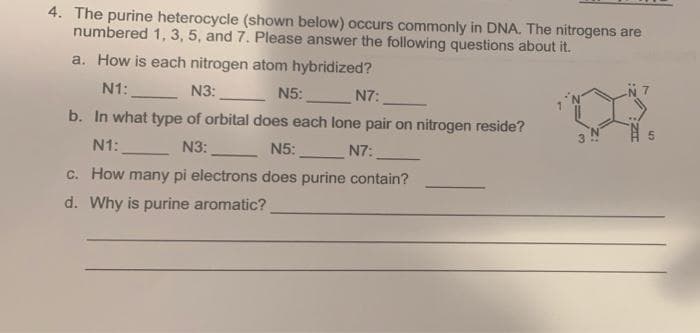4. The purine heterocycle (shown below) occurs commonly in DNA. The nitrogens are numbered 1, 3, 5, and 7. Please answer the following questions about it. a. How is each nitrogen atom hybridized? N1: N3: N5: N7: b. In what type of orbital does each lone pair on nitrogen reside? N1: N3: N5: N7: C. How many pi electrons does purine contain? d. Why is purine aromatic?
4. The purine heterocycle (shown below) occurs commonly in DNA. The nitrogens are numbered 1, 3, 5, and 7. Please answer the following questions about it. a. How is each nitrogen atom hybridized? N1: N3: N5: N7: b. In what type of orbital does each lone pair on nitrogen reside? N1: N3: N5: N7: C. How many pi electrons does purine contain? d. Why is purine aromatic?
Organic Chemistry: A Guided Inquiry
2nd Edition
ISBN:9780618974122
Author:Andrei Straumanis
Publisher:Andrei Straumanis
Chapter3: Electron Orbitals
Section: Chapter Questions
Problem 6CTQ
Related questions
Question

Transcribed Image Text:4. The purine heterocycle (shown below) occurs commonly in DNA. The nitrogens are
numbered 1, 3 , 5, and 7. Please answer the following questions about it.
a. How is each nitrogen atom hybridized?
N1:
_ N3:
N5:
N7:
b. In what type of orbital does each lone pair on nitrogen reside?
3
N1:
N3:
N5:
N7:
c. How many pi electrons does purine contain?
d. Why is purine aromatic?
Expert Solution
This question has been solved!
Explore an expertly crafted, step-by-step solution for a thorough understanding of key concepts.
This is a popular solution!
Trending now
This is a popular solution!
Step by step
Solved in 2 steps with 1 images

Knowledge Booster
Learn more about
Need a deep-dive on the concept behind this application? Look no further. Learn more about this topic, chemistry and related others by exploring similar questions and additional content below.Recommended textbooks for you

Organic Chemistry: A Guided Inquiry
Chemistry
ISBN:
9780618974122
Author:
Andrei Straumanis
Publisher:
Cengage Learning

Organic Chemistry: A Guided Inquiry
Chemistry
ISBN:
9780618974122
Author:
Andrei Straumanis
Publisher:
Cengage Learning